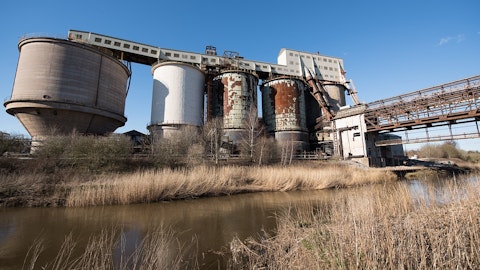Westlake Corporation (NYSE:WLK) Q3 2023 Earnings Call Transcript November 2, 2023
Westlake Corporation beats earnings expectations. Reported EPS is $2.2, expectations were $1.92.
Operator: Good morning, ladies and gentlemen. Thank you for standing by. Welcome to the Westlake Corporation Third Quarter 2023 Earnings Conference Call. [Operator Instructions] As a reminder, ladies and gentlemen, this conference is being recorded today, November 2, 2023. I would now like to turn the call over to today’s host, Jeff Holy, Westlake’s Vice President and Treasurer. Sir, you may begin.
Jeff Holy: Thank you, Maria. Good morning, everyone, and welcome to the Westlake Corporation conference call to discuss our third quarter 2023 results. I’m joined today by Albert Chao, our President and CEO; Steve Bender, our Executive Vice President and Chief Financial Officer, and other members of our management team. During the call, we will refer to our two reporting segments, Performance and Essential Materials, which we refer to as PEM or Materials; and, Housing and Infrastructure Products, which we refer to as HIP or Products. Today’s conference call will begin with Albert, who will open with a few comments regarding Westlake’s performance. Steve will then discuss our financial and operating results, after which Albert will add a few concluding comments, and we’ll open the call up to questions.
Today, management is going to discuss certain topics that will contain forward-looking information that is based on management’s beliefs as well as assumptions made by and information currently available to management. These forward-looking statements suggest predictions or expectations and thus are subject to risks or uncertainties. These risks and uncertainties are disclosed in Westlake’s Form 10-K for the year ended December 31, 2022, and other SEC filings. We encourage you to learn more about these factors that could lead our actual results to differ by reviewing these SEC filings, which are also available on our Investor Relations website. This morning, Westlake issued a press release with details of our third quarter results. This document is available in the Press Release section of our website at westlake.com.
We have also included an earnings presentation, which can be found in the Investor Relations section of that website. A replay of today’s call will be available beginning today, 2 hours following the conclusion of this call. This replay may be accessed via Westlake’s website. Please note that information reported on this call speaks only as of today, November 2, 2023. And therefore, you are advised that time-sensitive information may no longer be accurate as of the time of any replay. Finally, I would advise you that this conference call is being broadcast live through an internet webcast system that can be accessed on our web page at westlake.com. Now I would like to turn the call over to Albert Chao. Albert?
Albert Chao: Thank you, Jeff. Good morning, everyone. We appreciate you joining us to discuss our third quarter 2023 results. For the third quarter of 2023, we reported sales of $3.1 billion, net income of $285 million and EBITDA of $682 million, including record HIP segment EBITDA of $327 million. Our HIP segment benefited from resilient North American housing and infrastructure construction activities, while higher operating rates in our PEM segment drove sequential volume growth, despite generally lower average selling prices. The strength of our business portfolio was highlighted by the quarterly earnings achieved by our HIP segment where EBITDA exceeded the segment’s previous record set in the second quarter of 2022, during a much stronger housing and overall economic environment.
HIP segment EBITDA margin of 29% was also a record, driven by our strong brands and disciplined pricing in a period of lower material costs as well as solid progress in our cost-saving initiatives. The EBITDA generally in our HIP segment typically comes from with lower capital requirements than in our PEM segment and converts to cash flow generation at a higher rate, which is additional benefit of our vertical integration and downstream diversification strategy. We will have more to say about our HIP results and outlook later in the call. But I want to congratulate all of our HIP employees on their record performance. Overall, our third quarter results reflect the advantages of our portfolio diversification. While our PEM businesses experienced pricing pressure and margin compression, our housing and infrastructure businesses delivered significant cost and earnings improvement.
As a result, Westlake EBITDA margin of 22% was consistent with our second quarter margin of 21% and our prior year margin of 20%, demonstrating the earnings and cash flow stability of our strategy, to be a vertically integrated Performance and Essential Materials producer, combined with our value-added portfolio of leading offerings for Housing and Infrastructure Products. Our consistent focus on cash flow generation enabled Westlake to deliver $696 million in cash flow from operations in the third quarter and $1.8 billion year-to-date. The solid cash flow generation, the strength in the business and our confidence in the Company’s future allowed us to increase our dividend by 40% in August and to return approximately $180 million to shareholders since January.
I would now like to turn our call over to Steve to provide more detail on our financial results for the third quarter of 2023.
Steve Bender: Thank you, Albert, and good morning, everyone. Westlake reported net income of $285 million or $2.20 per share in the third quarter of 2023 on sales of $3.1 billion. Net income for the third quarter of 2023 decreased $116 million from the third quarter of 2022 as a result of lower average selling prices and integrated margins as well as lower sales volumes. When compared to the second quarter of 2023, net income decreased by $12 million in the third quarter of 2023 due primarily to lower prices and integrated margins for most of our products in our PEM segment partially offset by higher operating rates and sales volumes. For the third quarter of 2023, our utilization of the FIFO method of accounting had a $50 million unfavorable impact in pretax earnings compared to what earnings would have been if we reported on the LIFO method.
This is only an estimate and has not been audited. Before I discuss our segment results, I want to provide some high-level thoughts on the quarter. We were pleased with HIP segment’s ability to deliver value to our customers while managing cost to produce record earnings against a challenging North American housing backdrop. These results are a testament to the strength of our brands and the importance of our products to our customers. We believe this record performance illustrates the benefits of our vertical integration and diversification strategy as lower cost of materials used in our HIP segment drove margin expansion at a time when margins in our PEM segment compressed due to sales price decreases. The net result of this downstream integration was that Westlake delivered a 22% EBITDA margin in the third quarter compared to 21% in the second quarter and 20% in the third quarter of ‘22 despite a period of commodity price declines.
While we are pleased with the performance of our HIP segment, the financial results in our PEM segment continue to reflect soft global demand, and we are taking actions to address the challenging macroeconomic conditions. We continue to implement targeted actions to deliver cost savings in 2023. We now expect our company-wide reduction — cost reduction program to achieve $95 million to $110 million of cost savings in 2023, up from the previous $75 million to $105 million target, after we achieved approximately $80 million of cost savings to date in 2023. We are taking a prudent approach to managing costs, and capital investments in markets and regions that don’t contribute to our global feedstock and energy cost advantage or a vertical integration strategy.

Moving to the specifics of our segment performance. Our Housing and Infrastructure Products segment produced record quarterly EBITDA of $327 million on $1.1 billion of sales, the solid EBITDA growth of $73 million from the previous year EBITDA of $254 million. The year-over-year increase in EBITDA was due to lower materials cost that more than offset an 8% decrease in average sales price, driving expansion in our HIP segment EBITDA margin to 29% from 20% in the prior year period. When compared to the second quarter of 2023, HIP segment sales of $1.1 billion were driven by 7% growth in sales volume, which more than offset a 5% decrease in average sales price. Housing Products sales of $963 million in the quarter increased $45 million due to solid sales volume growth in Pipe & Fittings applications and Siding & Trim that more than offset lower average selling prices.
Meanwhile, Infrastructure Products sales of $181 million in the third quarter of 2023 decreased $16 million from the second quarter of 2023, primarily due to lower average selling prices and sales volumes in our compound business. The overall higher HIP segment sales in the third quarter of 2023, along with lower materials cost, drove an improvement in EBITDA margin to 29% from the 22% in the second quarter. As a result, HIP segment EBITDA increased $83 million from the second quarter to $327 million in the third quarter. Turning to our performance in Essential Materials segment. Third quarter 2023 sales were $2 billion with EBITDA of $339 million. When compared to the third quarter of 2022, EBITDA fell by $222 million due to lower average selling prices, particularly for Performance Materials in addition to lower sales volume, largely in epoxy driven by weak global demand and increased competition from Asian imports.
PEM segment EBITDA of $339 million in the third quarter decreased $96 million from the second quarter of 2023 as improved sales volumes, particularly for PVC resin and polyethylene were more than offset by a combination of lower average selling prices, particularly for caustic soda, PVC resin and epoxy, higher feedstock and energy cost and certain charges. Net sales in our PEM segment in the third quarter were 8% lower sequentially as volume gains over the second quarter were more than offset by price declines, which coupled with certain charges drove a decline in segment earnings. As the quarter progressed, we saw a modest improvement in pricing in some markets such as PVC and polyethylene while other markets continue to face pricing pressure.
Our PEM segment is globally competitive with a well-invested, vertically integrated position, processing a low-cost feedstock as we continue to grow our specialty and differentiated product offerings. Shifting to our balance sheet. As of September 30, 2023, cash and cash equivalents were $3.1 billion and total debt was $4.9 billion with a staggered long-term fixed rate debt maturity schedule. For the third quarter of 2023, net cash provided by operating activities was $696 million, while capital expenditures were $245 million, resulting in free cash flow of $451 million, which reflects our strong cash generative business model. We continue to look for opportunities to strategically deploy our balance sheet in order to create long-term value.
Now, let me provide some guidance for your models. Based on the current view of demand and prices and taking into account typical seasonality, we expect fourth quarter revenue in our Housing and Infrastructure Products segment to between $875 million to $975 million with EBITDA margins in the mid-teens. We also expect the $95 million to $110 million of savings in 2023 that I previously mentioned. We continue to expect total capital expenditures for 2023 to be approximately $1 billion, which is unchanged from our earlier guidance and is similar to our depreciation and amortization run rate. For the full year of 2023, we now expect our effective tax rate to be approximately 21%, which we will continue to expect our cash interest expense to be approximately $160 million.
Now, I’ll turn the call back over to Albert to provide a current outlook of our business. Albert?
Albert Chao: Thank you, Steve. Entering the fourth quarter, the economic backdrop remains challenging. The rate of inflation remains high and the mortgage rates are at the highest level in over 20 years. These inflationary and affordability pressures are negatively impacting consumer and housing demand. This volatile economic backdrop, combined with ongoing geopolitical turmoil and a normal seasonal decline in demand leads us to expect challenging conditions to continue throughout the fourth quarter. The uncertain macroeconomic outlook makes it difficult to predict demand trends over the next several quarters. That said, we believe that customer inventories are much lower today than they were at this time last year, which combined with the recent pricing momentum in some of our key products should reduce the degree of customer destocking activity in both our PEM and HIP segments relative to what we experienced in the fourth quarter of last year.
As we head into 2024, our leading market position with a broad product portfolio and strong brands, combined with our globally advantaged low-cost position, enable Westlake to respond to evolving market trends while executing our business strategies. Westlake has demonstrated a solid cash generative nature of our business, resulting in $2.6 billion in cash flow from operations on a trailing 12-month basis. We will continue to maintain a strong balance sheet and invest in our long-term strategic priorities while continuing to return capital to shareholders. Notably, our quarterly dividend has doubled over the last five years as a testament to our commitment to returning value to our shareholders. We are also reaffirming our commitment to our broader stakeholder community to improve the sustainability of our products and operations.
We continue to introduce new products into the market to meet customers’ sustainability requirements. In September, we are pleased to introduce our pivotal line of one-pellet solutions. This innovative portfolio of products incorporates up to 45% post-consumer recycled material into resin pellets with properties comparable to that of virgin resin. The product line has already achieved green circle certification, which independently validates our post-consumer recycled content efforts, and we’re seeing increasing interest from our customers for this more sustainable material. Separately, I’m pleased to announce that we have achieved an 18% reduction in our Scope 1 and Scope 2 to CO2 emissions intensities since 2016, moving one step closer to our goal of a 20% reduction by 2030.
As we continue to achieve significant progress, we will look for opportunities to increase our emission intensity reduction goals. Before we open the call to our questions, I want to provide some closing thoughts on the third quarter and our outlook. Our third quarter results highlight the benefits of our vertical integration and downstream diversification strategy. A key component of the strategy is the goal to reduce volatility earnings and cash flow, while maximizing growth potential. Recognizing that profitability can shift up or down the value chain, depending on economic conditions, we believe that it’s important to have a broad product portfolio with strong brands supported by a manufacturing culture focused on low-cost operational excellence.
In the third quarter, this strategy proved very beneficial as profitability moved to our downstream HIP businesses. Through the investment that we have made in our HIP segment in recent years, we’re able to capture this value shift to enhance the stability of our EBITDA margin and cash flows. As we look forward, we seek additional ways to broaden our business through organically and through acquisitions to further this strategy. Thank you very much for listening to our third quarter earnings call. I will now turn the call back over to Jeff.
Jeff Holy: Thank you, Albert. Before we begin taking questions, I would like to remind listeners that our earnings presentation is available on our website, and a replay of this teleconference will be available starting 2 hours after this call has ended. Maria, we will now take questions.
See also Goldman Sachs EV and Battery Stocks: Top 10 Stock Picks and 11 ChatGPT Penny Stock Picks.
Q&A Session
Follow Westlake Corp (NYSE:WLK)
Follow Westlake Corp (NYSE:WLK)
Operator: [Operator Instructions] Our first question comes from the line of Patrick Cunningham from Citi.
Patrick Cunningham: What drove the pricing declines in the HIP segment for the quarter? Was it broad-based, or are there any specific areas of pricing pressure to highlight? And any sort of outlook into 4Q and into next year would be helpful.
Steve Bender: Yes. So, when you think about some of the pricing decline, we saw certainly — we’re seeing certainly in pockets and some of these portfolio offerings where there is pressure. Certainly, you can see when you think about the quarter compared to second quarter, we certainly had nice volume pickup, 7% volume pickup over Q2. But certainly, as we all know, affordability is an issue in the housing sector. And so certainly, to continue to be performing very solidly as we did, in fact, record results, there is some pressure in certain segments within that portfolio within HIP.
Patrick Cunningham: Got it. And then just a similar follow-up. I appreciate the sales and EBITDA guide for the HIP segment. The narrower 4Q sales range seems to point maybe towards the bottom end of your previous range. Is this some indication that the business might be more challenged beyond just what you would expect from typical seasonality, or are there any other negative trends to point to there?
Steve Bender: Well, it is a combination, Patrick, of both seasonal play plus we’ve seen certainly the compounding effect of interest rates and impacting affordability. But certainly, it’s a combination of both that impact of rising interest rates for mortgages and certainly a seasonal play. So, that’s really the two primary drivers within the guidance that we’ve provided.
Operator: Our next question comes from the line of Frank Mitsch from Fermium Research.
Frank Mitsch: If I could follow up on HIP. Obviously, very impressive EBITDA margins of 29% in the third quarter. And based on your guidance, it looks like the year is probably going to come in close to like 22% or so for the full year, which is up 200 bps from last year. How do you think about normalized EBITDA margins in HIP as you look out into ‘24 and beyond?
Steve Bender: Yes, Frank, good question. And certainly, I think you see from the strong portfolio offering that we had and the acceptance by our broad customer base that we continue to perform even very well in a period of rising interest rates. And so, I think the portfolio we offer does provide an ability to deliver really strong and compelling EBITDA margins in this business. It is a combination of what I would call exterior building products. Of course, our infrastructure products going into some of the infrastructure markets that we’re seeing, both pipes and fittings, and of course, our portfolio adds compounds, which goes into a variety of applications, whether it is building wire or other applications in automotive or medical.
So, it’s a broad portfolio offering. And I think the portfolio we offer attracts, I think, the kind of good margins that you see even in the face of these strong headwinds we’ve seen, given interest rates and some of the pricing pressures. So, I do believe that it’s performing incredibly well, and we expect it to continue to be strongly performing.
Frank Mitsch: That’s helpful — yes, hi, go ahead, please.
Albert Chao: It’s Albert. I just want to comment that, I think, Steve, in the past has said, our target for the HIP business EBITDA margin is the high-teens. Now, it can go up and down depending on the time of the season. Usually, it’s maybe higher second and third quarter, lower first and fourth quarter.
Frank Mitsch: Understood. And then obviously, then this does appear to be somewhat of an anomalous year, and I was trying to get at that. But I also think that the cost improvement that you’ve talked about, you’ve raised your target for the year fairly significantly. You did $80 million year-to-date. How much of that cost improvement is coming from the HIP segment versus PEM?




